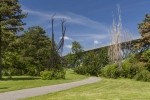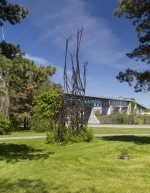Robert Roussil
Girafes
1966
Presentation of the artwork
Girafes is a steel sculpture 11.8 metres high whose shape evokes a group of four giraffes.The artwork is formed of steel rods used as they would be in a structure frame. The simple, common material contrasts with the surprising complexity of the composition. The shapes of the rods describe broken circles and curves, recurrent elements in Roussil’s work, that transform the apparent rigidity of the material into a sculpture that is transparent and light.
The rods also create a volume and produce an effect of unity, so that the metamorphosis of the material draws the gaze and becomes the subject of the artwork. The artist conceived the work of the sculptor similarly: “One must destroy things in a way to return to one’s equilibrium.” 1
1. Marcel Fournier, “Entretiens: Robert Roussil ou l’esprit d’entreprise,” Les générations d’artistes (L’institut québécois de recherche sur la sculpture, 1986), p. 111 (our translation).
Associated events
The artwork was commissioned in 1966 by the Canadian Corporation for the 1967 World Exhibition to stand outside the Garden of Stars during the event. In 1971, after it was restored by the artist, the artwork was installed in Place de la Russie on Île Notre-Dame; it was moved to its current site in 1974.
Robert Roussil
A former member of the military, Robert Roussil (Montréal 1925–Tourettes-sur-Loup 2013) received his artistic education at the school of decorative arts and design at the Montréal Museum of Fine Arts (1945–46). His wood sculptures – habitable spheres and monumental modular structures – challenged, sometimes controversially, the function of public and private spaces.
Roussil participated in symposiums in Yugoslavia, Montréal, and Grenoble and produced numerous large-scale public art projects in Québec and abroad, including a sculpture park on the roof of a wastewater treatment plant in Saint-Laurent-du-Var, France.
Roussil participated in symposiums in Yugoslavia, Montréal, and Grenoble and produced numerous large-scale public art projects in Québec and abroad, including a sculpture park on the roof of a wastewater treatment plant in Saint-Laurent-du-Var, France.
Presentation of the artwork
Girafes is a steel sculpture 11.8 metres high whose shape evokes a group of four giraffes.The artwork is formed of steel rods used as they would be in a structure frame. The simple, common material contrasts with the surprising complexity of the composition. The shapes of the rods describe broken circles and curves, recurrent elements in Roussil’s work, that transform the apparent rigidity of the material into a sculpture that is transparent and light.
The rods also create a volume and produce an effect of unity, so that the metamorphosis of the material draws the gaze and becomes the subject of the artwork. The artist conceived the work of the sculptor similarly: “One must destroy things in a way to return to one’s equilibrium.” 1
1. Marcel Fournier, “Entretiens: Robert Roussil ou l’esprit d’entreprise,” Les générations d’artistes (L’institut québécois de recherche sur la sculpture, 1986), p. 111 (our translation).
Associated events
The artwork was commissioned in 1966 by the Canadian Corporation for the 1967 World Exhibition to stand outside the Garden of Stars during the event. In 1971, after it was restored by the artist, the artwork was installed in Place de la Russie on Île Notre-Dame; it was moved to its current site in 1974.
Robert Roussil
A former member of the military, Robert Roussil (Montréal 1925–Tourettes-sur-Loup 2013) received his artistic education at the school of decorative arts and design at the Montréal Museum of Fine Arts (1945–46). His wood sculptures – habitable spheres and monumental modular structures – challenged, sometimes controversially, the function of public and private spaces.
Roussil participated in symposiums in Yugoslavia, Montréal, and Grenoble and produced numerous large-scale public art projects in Québec and abroad, including a sculpture park on the roof of a wastewater treatment plant in Saint-Laurent-du-Var, France.
Roussil participated in symposiums in Yugoslavia, Montréal, and Grenoble and produced numerous large-scale public art projects in Québec and abroad, including a sculpture park on the roof of a wastewater treatment plant in Saint-Laurent-du-Var, France.






